What’s the Point?
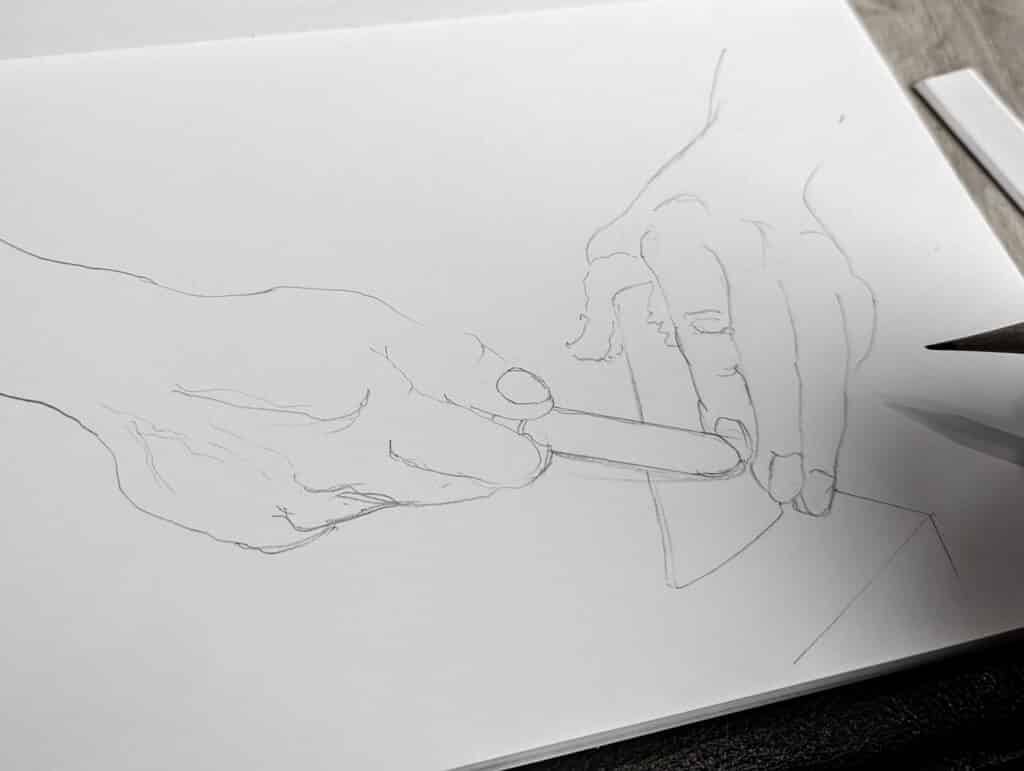
For me, my pencil point is very much the same as a chisel edge and saw teeth, they might need to, can be and should now and then be sharpened slightly or majorly differently––sharpened to task, as it were. Legalism has always choked off creativity. I think it always will. Following fixed and rigid rules becomes very like painting by numbers. We don’t need a rule book and we don’t work too well with a colouring book––staying in the lines and such. But rules are good starting out––they can establish patterns and muscle memory so I’m good with that. That is until we develop and grow our ability to flex in the saddle here and there. Developing flex is good! High rise anything as far as structures go, not pyramids, rarely works without the ability to flex under pressure. Many a structure would be brought down through wind pressures without the ability to sway a little here and there.
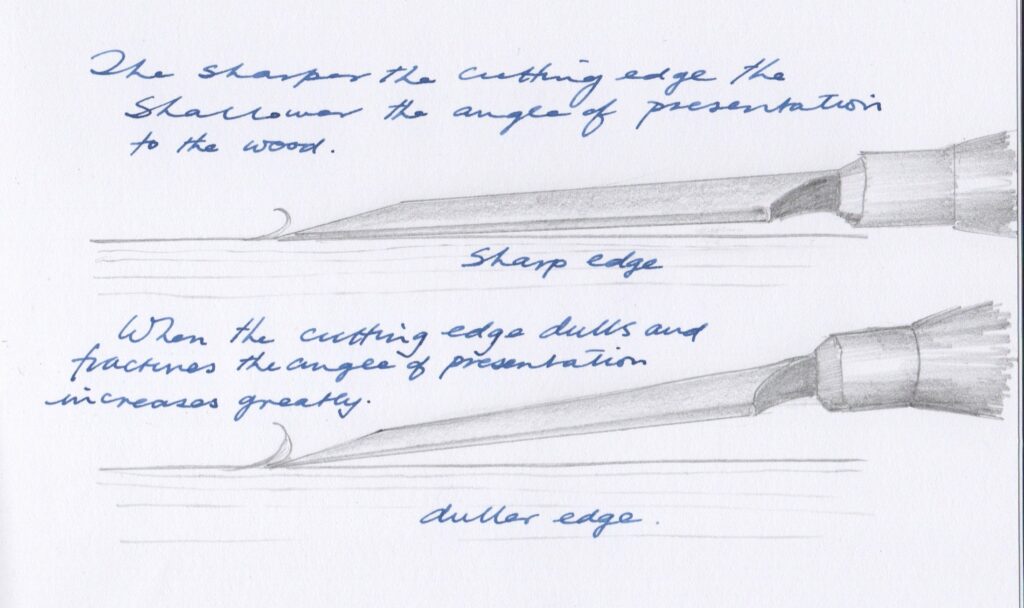
As soon as the freshly sharpened chisel touches any surface of wood to pare cut or chop, we lose the edge by some often immeasurable amount. There have been times with some woods and some special task where I have sharpened up four or five times in an hour even though the tool might only be used for a minute or so over that whole hour. Any edge tool is less sharp in some measure and it can show on woods with a more spongy resistance where the wood compresses markedly until the compressing wood springs back into the cutting edge. Think Newton’s law of third motion.
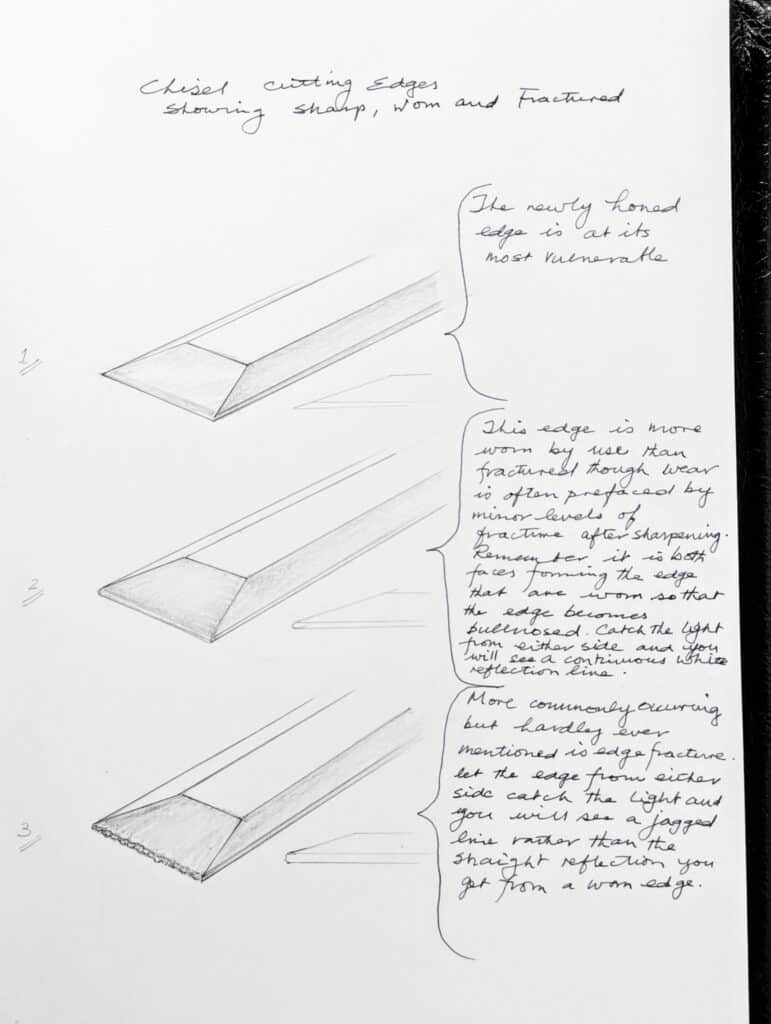
The hardness of a chisel edge or pencil point does not mean that they don’t fracture because that’s exactly what they do. Depending on how they are used and what for will determine how and to what level they indeed hold up. “Hold up‘ will be less to do with hardness than edge retention but often we fail to see that whereas hardness and the degree of it will usually dictate how often we must return to sharpening it rather than strength and durability. When we consider a cutting edge or pencil point that fails to cut or mark cleanly we almost always say that the tool or point is dull or blunt. These two terms are not one and the same. Dull, in essence, means blurry and ill-defined whereas blunt, though it can mean dull or abrupt, in this circumstance will mean worn down by erosion. Whereas that can and often will be the case, I venture to say that most often, when I take the time to actually look, it is less usual to be dulled by wear than being actually fractured. The difference between the two terms, dull and fractured, would then be because one is worn away and the other is broken by fracture. The outcome in use then will be equally different. The fractured edge will often show as a fractured cut line in the wood surface, the dull edge a more bruised one where the edge wood yielded and to the point of being turned in. These are small outcomes but telling. Rarely or ever is this a consideration for most. Of course, this is all by degree. Think worn to be like river rocks eroded gradually over many centuries of water pouring over the same rocks. The rock’s outer surface look worn and have no visible sharp or angular corners. Often, the chisels or plane irons, saw teeth, etc are indeed worn away in similar fashion by the cutting edges being rubbed or pushed into a resistant material as with wood. I think that in actuality the first passes after sharpening start out as minute fracture and subsequent continuation in use takes the edge into a wearing zone. But there are often times when the edges and points simply fracture on the first points of contact with the material be that wood or paper and resharpening need is obviated immediately if we are sensitive. Chiseling fractious knots will almost always fracture the chisel and the plane iron edges. So too the teeth points of saws and especially cross-cut saws that have a their three-sided point. This is why we woodworkers generally avoid scraping wood with our chisels held perpendicular to the wood’s surface.
Now to the Real Point
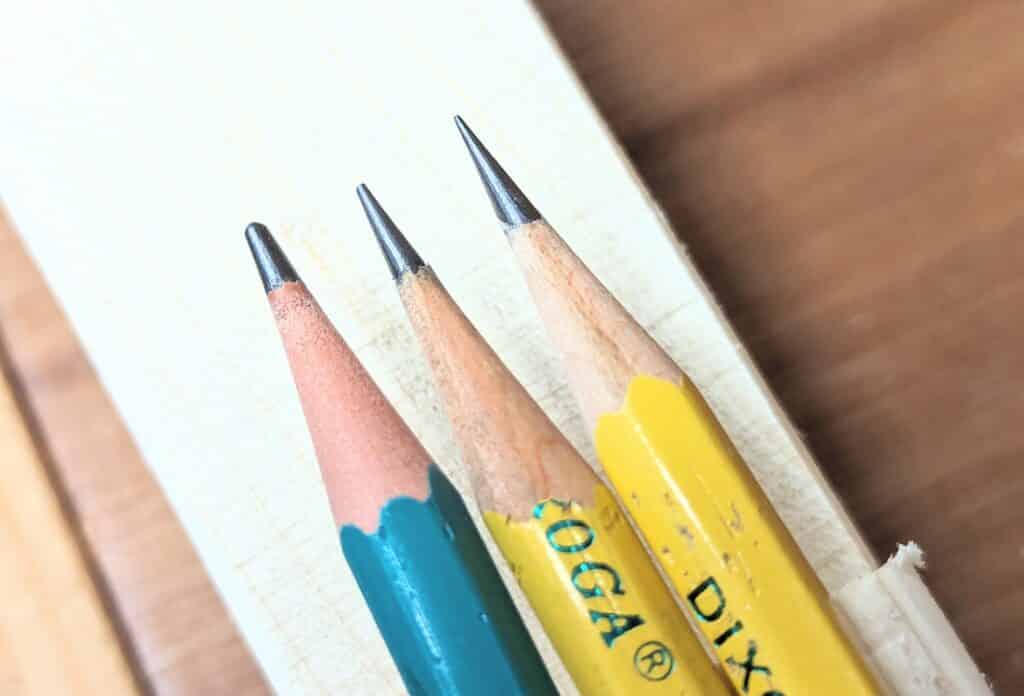
All too often we will think, as with the chisel edges and the saw points, that a one-point-fits-all situations for drawing and whereas we can make that work. the nice thing about pencils of any kind is that they are so easily and readily refined to suit quite specific tasks ranging from pin-point dots to broad-stroke shading, soft-stroke, edgeless lines to super-fine and variable versions.
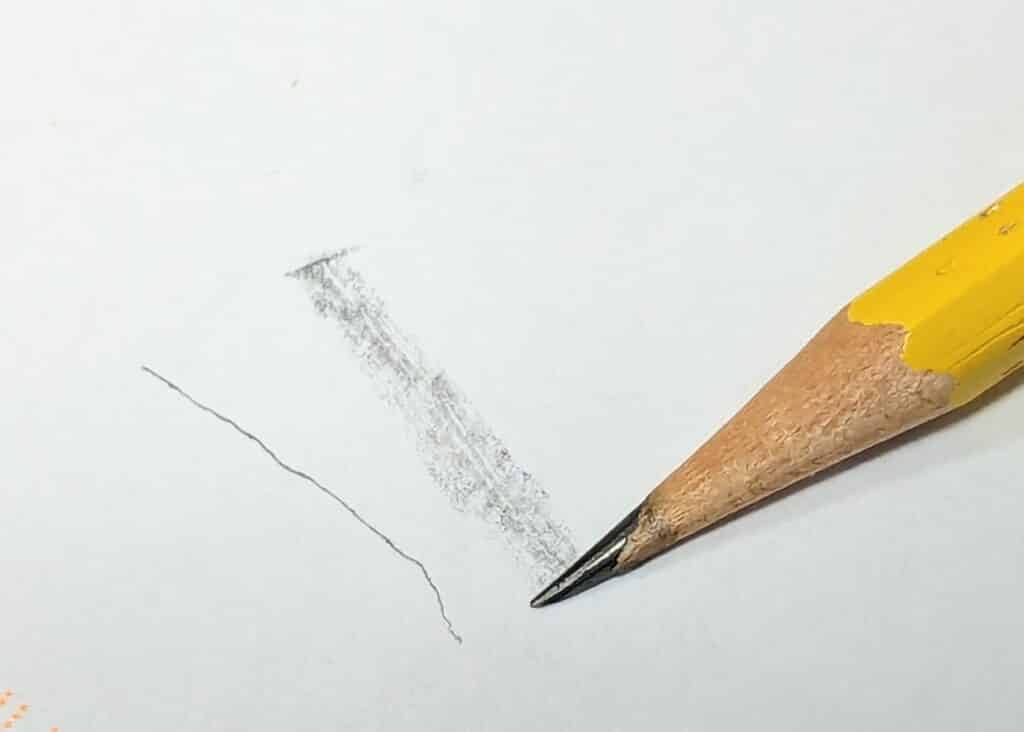
The angle of presentation to the work surface of paper also gives infinite variability so combining this with the different choices of points we create can allow and require substantive decision making. For much of my drawing and sketching, I keep the same grade of pencils in my unique pouch. On my workbench I keep the yellow Ticonderoga #2s pretty much pristinely sharp whereas the green ones I allow to own a rounded point.
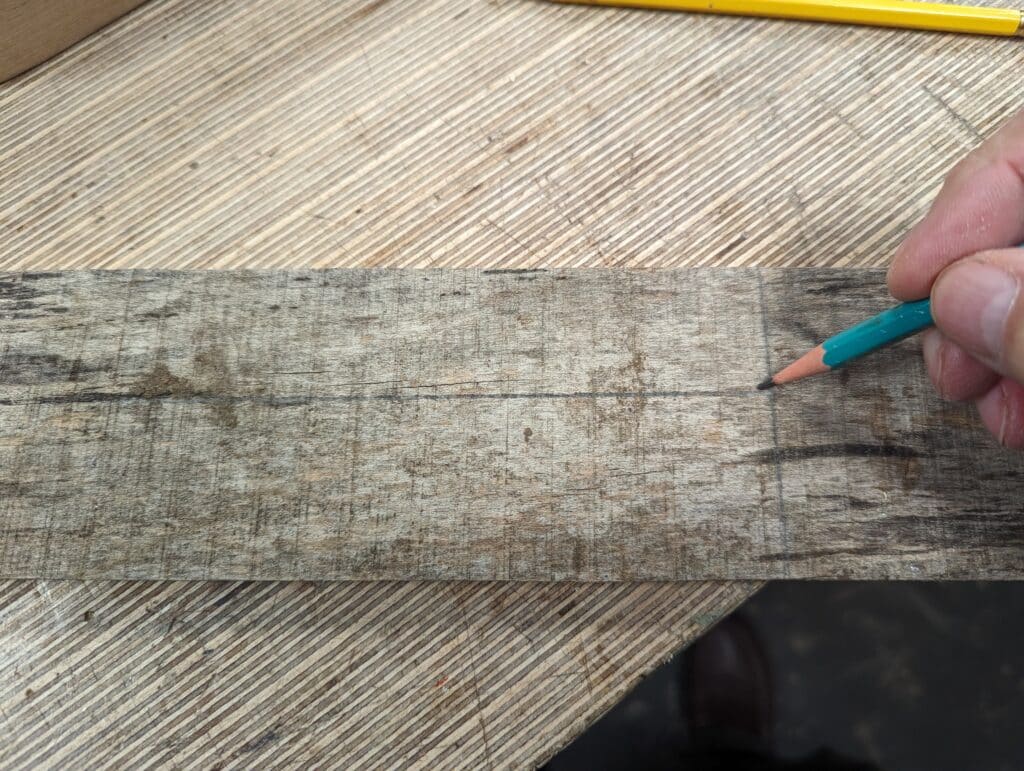
The difference is simple; yellow ones are always the ones I keep for laying out lines, the green ones I use for marking on rougher wood surfaces as the thicker markings show up the better with the thicker marks a round pointed pencil delivers.
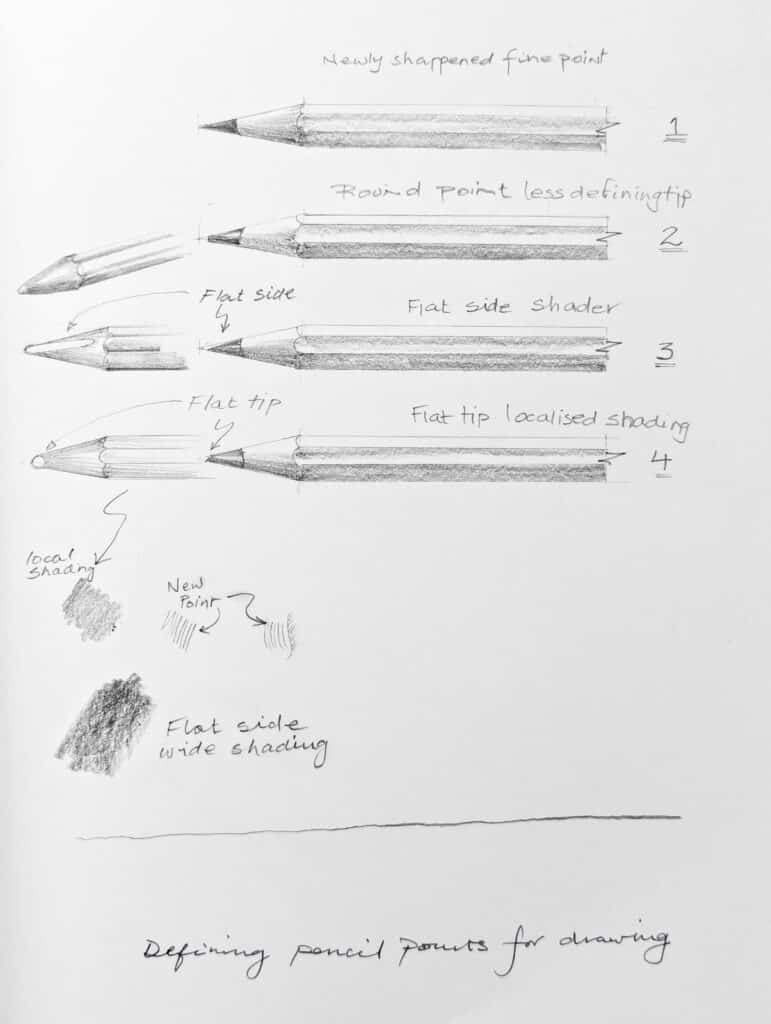
For drawing, my needs are quite different. The sharp points I like for my woodworking layout need constant renewal minute by minute. The #2 is my preference because the softness leaves a clear black line. Harder ‘H’ grade pencil graphite will hold the point better but are too light to be seen on several wood types yet excellent for technical drafting.

The image below show how I have flattened one side of the conical point for broad shading . . .
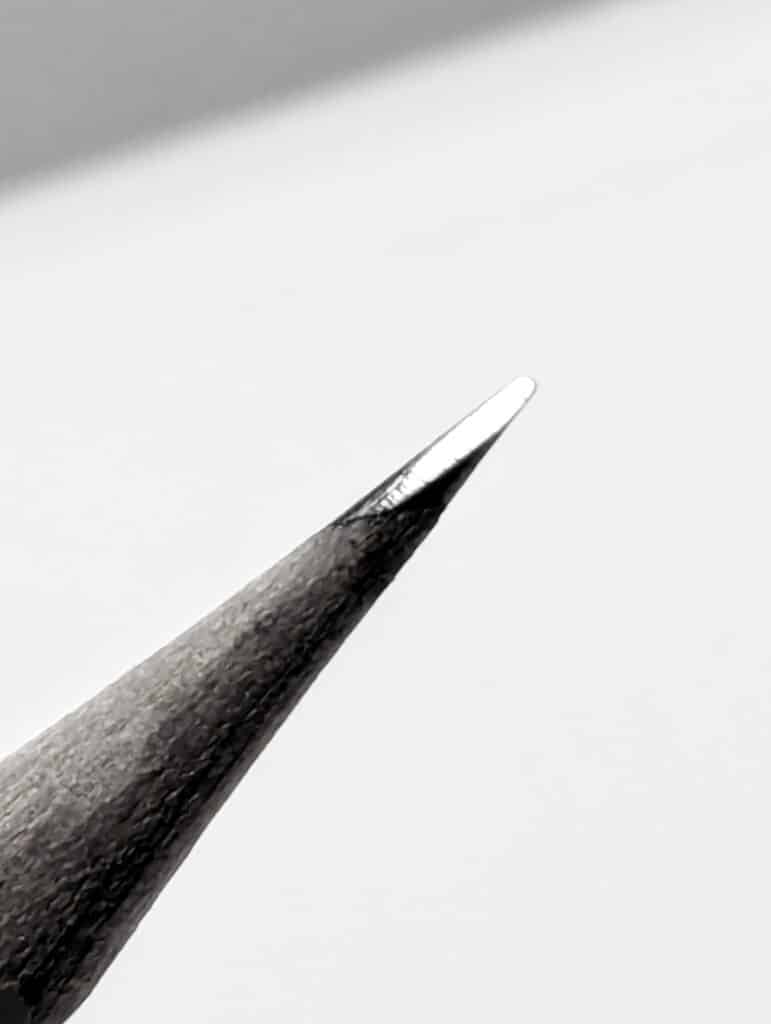
. . . but that by rotating the pencil i can also have a super sharp pencil point for detail work. This give me two refinements useful to my work.
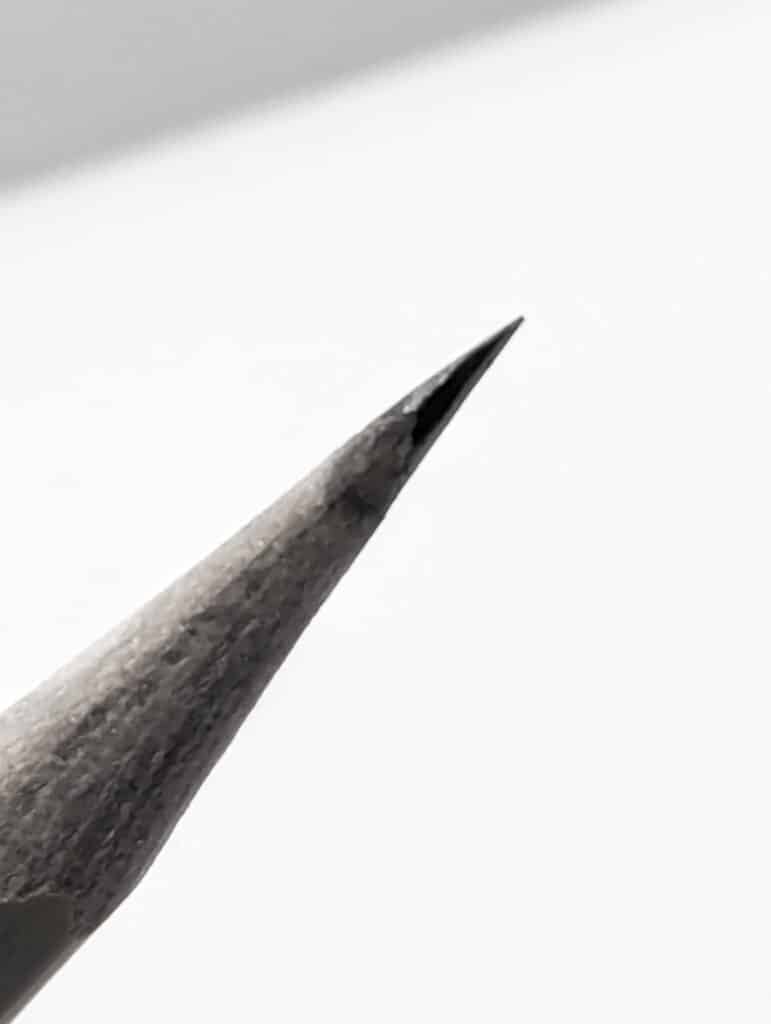
The flat face is useful for shading wide expanses.
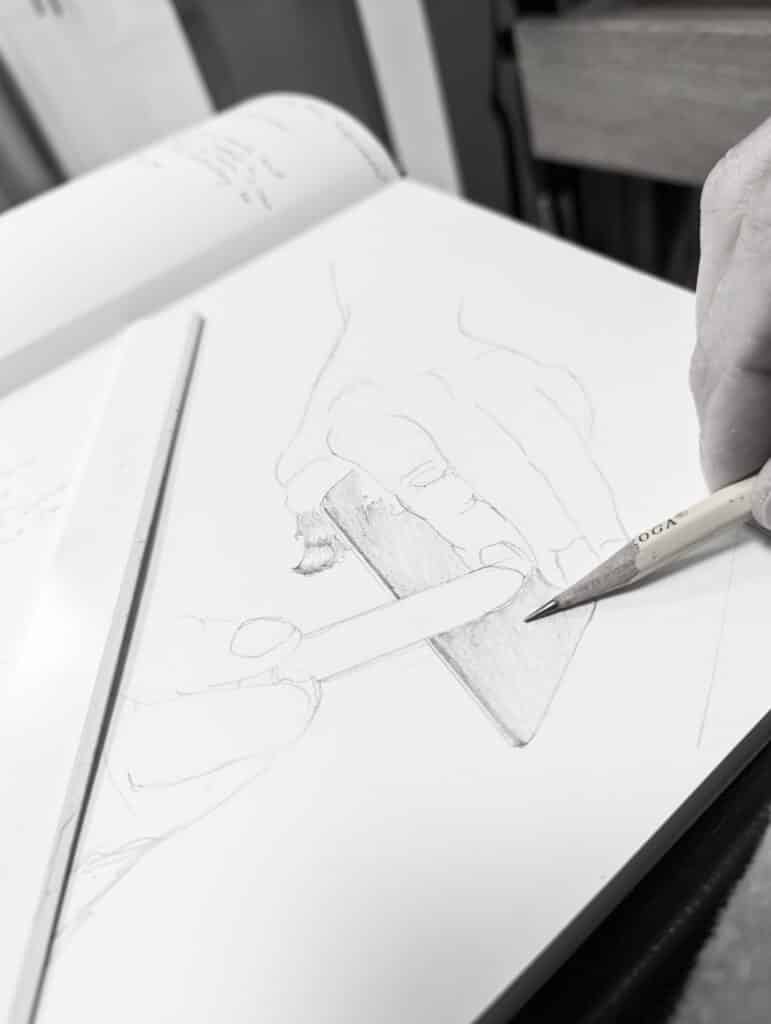
In my outline I offer my first outlined statement. The enables me to consider perspective and sizing, shape and so on before I put more work into the drawing. Because my medium is erasable I can make adjustments until I get it right.
Different pencil strokes from different point refinements allow me to make texture detailing as `I go. This then tackles technique, tone, additional depth and ultimately tonal intensity and so on.
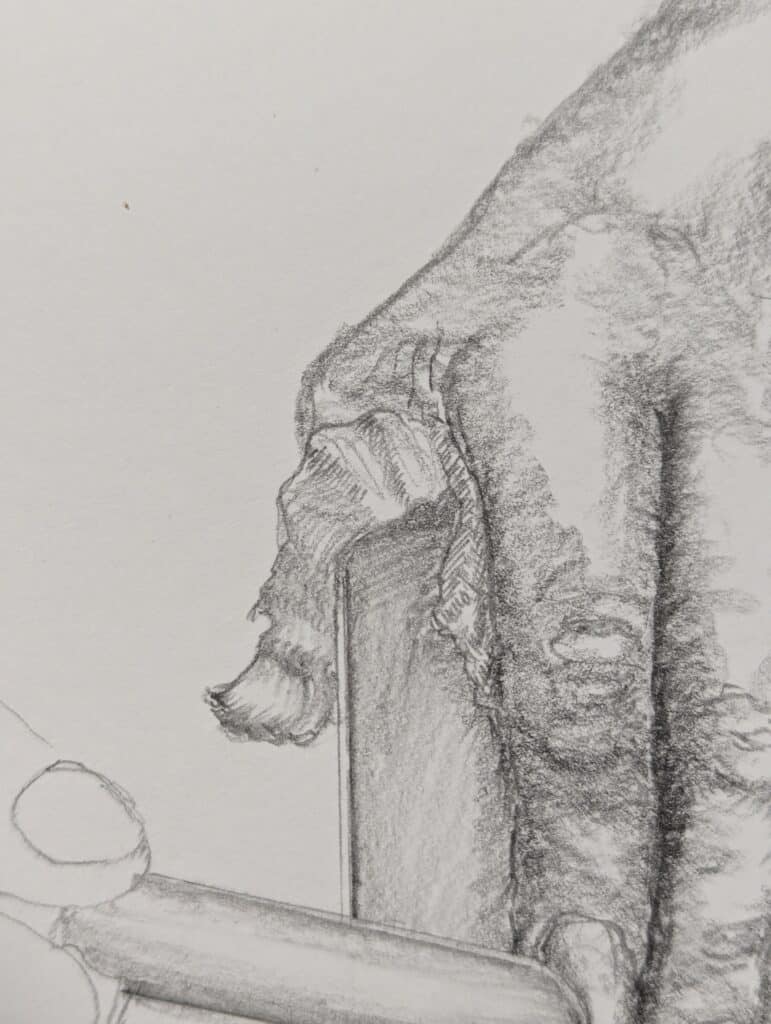
In my drawing working hands that work with one another they must be oriented just right otherwise the task being carried out will not express the correct characteristic.
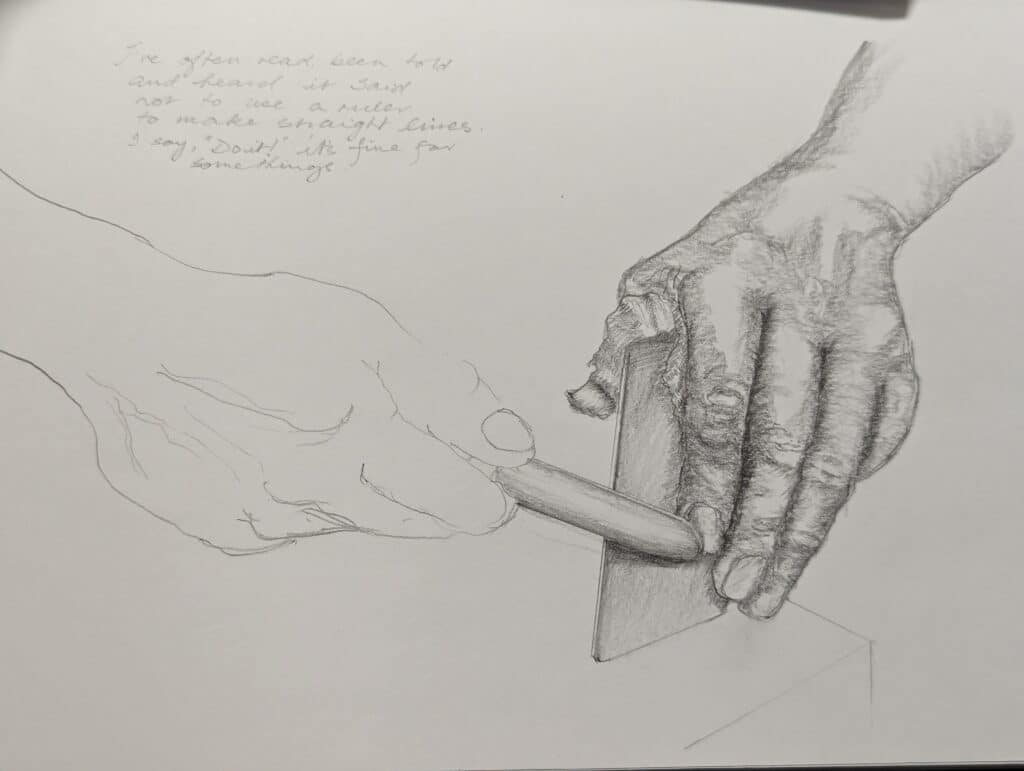
A drawing is done when it’s done. I keep my drawings for weeks and months and often go back to add more.
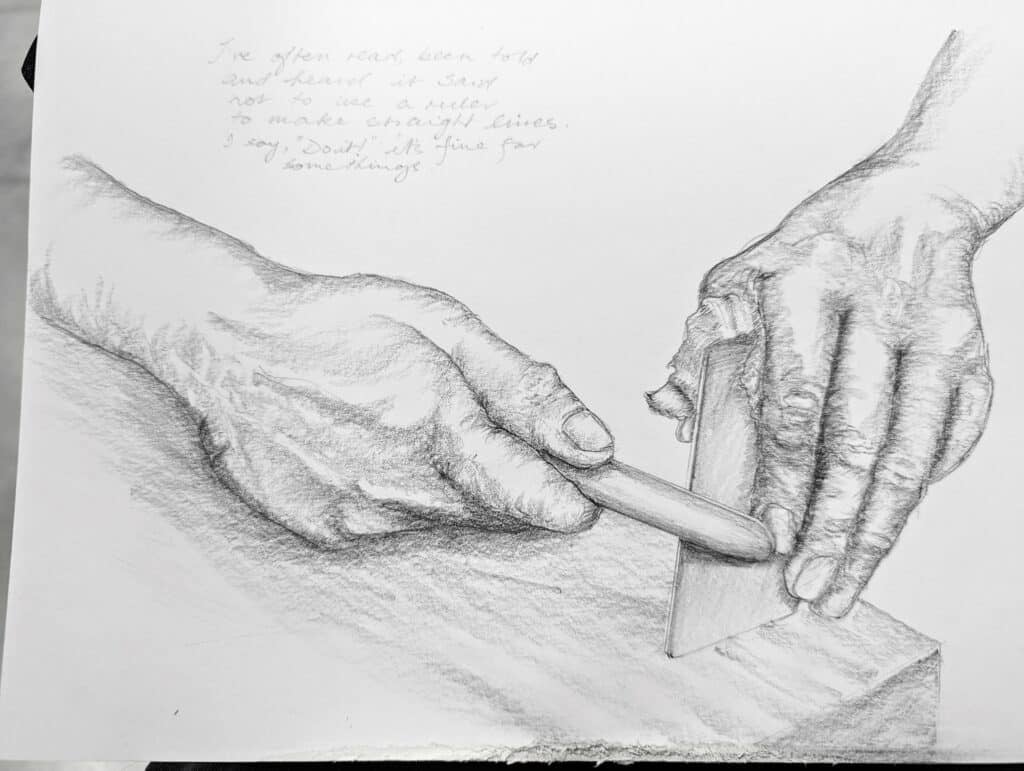


Didn’t realize you were that accomplished as an artist! Expected only a draftsman.
“Only” a draftsman? Artist or draftsman, the gift is in being able to put on paper what the eye or mind sees. Wish I had it.
So many praying for Paul’s recovery. It’s worked for me many times.
Get well soon, Paul!
Hi Paul, Hope you are mending well.
I have so loved your drawings ever since I found you on YouTube a few years ago. Back when you were building the thick top workbench in the back yard with school children heard playing in the background.
Will you ever publish your drawings in a book?
Praying for your speedy recovery.
Jim
Prayers for quick and full healing for you, Sir.
Never ever gave pencils this much thought. I’ve learned something new today and before my 2nd cup of coffee.
Might their be a book of drawings soon?
It never dawned on me to organize my pencils sharpness by color!
I do use a really thin leaded mechanical pencil that will slip into my knife walls when I need the visual aid.
Another thing lacking in school curriculums besides shop classes is drawing skills.
I did take drafting and I liked it but I grew dependent on straight edges.
Of course now that’s all gone because drawing is done by computers.
Great article! Thanks and best wishes.
I enjoyed this read. thanks!
Paul, hope you are mending and recovering your strength. Your lifestyle (and attitude) has kept you in amazing shape so I expect to see you back at the bench very soon (in fact I’m counting on it). In my retirement, I’ve started to draw and paint again. There is a beautiful relationship between sketching and woodworking I think. Both require training the eye as well as the hand and once focused on a task, hours seem like minutes. Another benefit is wood workers never have a shortage of beautiful and complex objects to sketch or study. My trusty #4 or drawknife or other hand tool make very satisfying and challenging subjects to sketch or draw (especially with some good lighting like morning light streaming into the shop). Funny, I haven’t drawn any of my smaller power tools (drills mostly) even though they have some complex shapes/textures too. Just not as connected to those shapes as the more organic, time tested shapes (of a bench plane for example).
Thanks for being an inspiration to so many. Cheers
(P.S. I’m so going to use the colored pencil system you described, that’s really so simple and useful)
Hello Paul, a while back, I saw one of your videos where you emphasized the importance of sharp pencils. I never realized how much error I was introducing in my work by not using a fine point. I ended up buying a special pencil sharpener that has two different blades, to achieve a very fine point. It made a huge difference in the accuracy of my layout lines. The only drawback is, pencil sharpness has become an obsession…
Paul, As an artist from childhood and a woodworker since my 20’s, I always learn from watching you. Both drawing and woodworking. Keep up the great work and heal well!
I appreciate the nuanced approach to pencil marking but I have a problem I have not been able to resolve concerning marking very narrow pins off dovetails.
I find that the opposite dovetail from the pin I’m marking prevents the pencil point from kissing the dovetail bottom. There is always a little gap between the pin board and the dovetail.
Any suggestions
Yes, you will soon get used to adjusting for that gap as I have through the years. my dovetails always come directly from the saw and I very rarely need to refit a cut with a chisel. But that is on soft-grained woods like pines, spruces and such. Hardwoods I usually mark with a knife but not every time.
Hi Paul,
I always enjoy seeing your drawings. I wonder: are you self-taught or did you have some sort of training/tutoring for your pencil skills? Can you maybe recommend a book?
Thank you!
Simon
Hello Simon, I think we learn well from seing art and every artist ultimately develops this thing we call ‘Their own style.’ This is usually undergirded by adopting a few basic principles for drawing to better understand where we want to go and what steps it takes to get there. I am utterley self taught in these free-style type study whereas I took drafting in college in the pre-sketchup years beyond back in the mid to latter part of the 1960s when we used scale rules, T squares and set-square triangles to create isometric projection as the method for visually representing our three-dimensional objects two-dimensionally to work from. These came as extensions from our orthographic projections which are the flat faces of different sides of an item so effectively we can see three sides of an object in one view. This type of rigid drawing was and is still called technical or engineering drawings. It is an axonometric projection in which the three coordinate axes appear equally foreshortened and the angle between any two of them is 120 degrees.I am often told of a book that others recommend regularly called Drawing on the Right Side of the Brain and though I own it I have never actually read it. I think being unsullied by taught art has been the best thing for me. I look at the art of others and look for a technique I might want to use and add to my working practices. Though this is not being formally taught it is learning through the work of others in the samne wway we look at how others work in woodworking and copy techniques and adopt ideas. I am working on another blog post to help people to first consider starting out and secondly to apply a few principles and reasons to do so. Not everyone wants to or can use an iPad for drawing using different apps. I do but on a limited level. because I can draw it’s much quicker for me in the same way my cutting a dovetail from scratch will always be ten times faster and more efficient with a superior outcome than using a power router.
“A man will be satisfied with good by the words of his mouth, and the work of a man’s hands will reward him.” HCSB Proverbs 12: 14.
For those wandering, a #2 pencil is equivalent to an HB pencil which is the one ordinary used for writing and generally available. The other 19 grades from 9B (very soft) to 9H (very hard) are not available in every shop.
hypothetical: one day a big fire burns all your tools and your shop. you only have enough time to dash in and save one precious tool. which one and why?